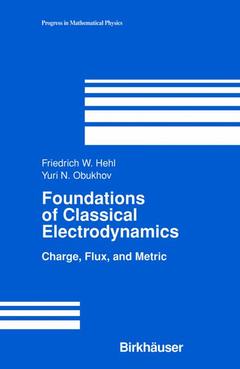Description
Foundations of Classical Electrodynamics, 2003
Charge, Flux, and Metric
Progress in Mathematical Physics Series, Vol. 33
Authors: Hehl Friedrich W, Obukhov Yuri N.
Language: English
Subject for Foundations of Classical Electrodynamics:
89.66 €
Subject to availability at the publisher.
Add to cart
Foundations of Classical Electrodynamics
Publication date: 08-2003
113 p. · 15.5x23.5 cm · Hardback
Publication date: 08-2003
113 p. · 15.5x23.5 cm · Hardback
63.29 €
In Print (Delivery period: 15 days).
Add to cart
Foundations of Classical Electrodynamics
Publication date: 10-2012
113 p. · 15.5x23.5 cm · Paperback
Publication date: 10-2012
113 p. · 15.5x23.5 cm · Paperback
Description
/li>Contents
/li>
In this book we display the fundamental structure underlying classical electro dynamics, i. e. , the phenomenological theory of electric and magnetic effects. The book can be used as a textbook for an advanced course in theoretical electrodynamics for physics and mathematics students and, perhaps, for some highly motivated electrical engineering students. We expect from our readers that they know elementary electrodynamics in the conventional (1 + 3)-dimensional form including Maxwell's equations. More over, they should be familiar with linear algebra and elementary analysis, in cluding vector analysis. Some knowledge of differential geometry would help. Our approach rests on the metric-free integral formulation of the conservation laws of electrodynamics in the tradition of F. Kottler (1922), E. Cartan (1923), and D. van Dantzig (1934), and we stress, in particular, the axiomatic point of view. In this manner we are led to an understanding of why the Maxwell equa tions have their specific form. We hope that our book can be seen in the classical tradition of the book by E. J. Post (1962) on the Formal Structure of Electro magnetics and of the chapter "Charge and Magnetic Flux" of the encyclopedia article on classical field theories by C. Truesdell and R. A. Toupin (1960), in cluding R. A. Toupin's Bressanone lectures (1965); for the exact references see the end of the introduction on page 11. .
Preface y.- Five plus one axioms.- Topological approach.- Electromagnetic spacetime relation as fifth axiom.- Electrodynamics in matter and the sixth axiom.- List of axioms.- A reminder: Electrodynamics in 3-dimensional Euclidean vector calculus.- On the literature.- References.- A Mathematics: Some Exterior Calculus.- Why exterior differential forms?.- A.1 Algebra.- A.2 Exterior calculus.- A.3 Integration on a manifold.- References.- B Axioms of Classical Electrodynamics.- B.1 Electric charge conservation.- B.2 Lorentz force density.- B.3 Magnetic flux conservation.- B.4 Basic classical electrodynamics summarized, example.- B.5 Electromagnetic energy-momentum current and action.- References.- C More Mathematics.- C.1 Linear connection.- C.2 Metric.- References.- D The Maxwell—Lorentz Spacetime Relation.- D.1 A linear relation between H and F.- D.2 Propagation of electromagnetic waves: Quartic wave surface.- D.3 First constraint: Electric/magnetic reciprocity.- D.4 Second constraint: Vanishing skewon field. Emergence of the light cone.- D.5 Extracting the metric by an alternative method.- D.6 Fifth axiom: Maxwell-Lorentz spacetime relation.- References.- E Electrodynamics in Vacuum and in Matter.- E.1 Standard Maxwell-Lorentz theory in vacuum.- E.2 Electromagnetic spacetime relations beyond locality and linearity.- E.3 Electrodynamics in matter, constitutive law.- E.4 Electrodynamics of moving continua.- References.- ®Outlook.- How does gravity affect electrodynamics?.- Reissner—Nordström solution.- Rotating source: Kerr—Newman solution.- Electrodynamics outside black holes and neutron stars.- Force-free electrodynamics.- Remarks on topology and electrodynamics.- Superconductivity: Remarks on Ginzburg—Landau theory.- Classical (first quantized) Dirac field.-On the quantum Hall effect and the composite fermion.- On quantum electrodynamics.- On electroweak unification.- References.- Author Index.
© 2024 LAVOISIER S.A.S.
These books may interest you

Theoretical Physics 3Electrodynamics 105.49 €



